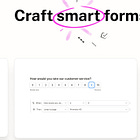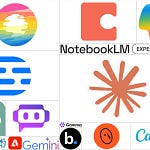Summary: Bloks is simple AI-powered software I use and recommend to record and summarize meetings. Read on for how it works, how to make the most of Bloks, and a few limitations and alternatives. If you’re a visual person, watch my 4-minute video summary above or on YouTube.
How Bloks works
Bloks runs on your computer, transcribing and summarizing online or in-person meetings. Unlike other meeting recorders or summary tools, it’s not a bot that joins your meetings. Bloks acts like a small recorder on your computer, so it doesn’t have to be invited or admitted by a meeting host.
Prepare for your day
In advance of your meetings, Bloks can brief you on those with whom you’re meeting. After you link Bloks to your calendar, it looks up public info on people you’re meeting with. You then get a summary of the person’s background and focus areas, drawn from LinkedIn. (This functions a bit like another tool I wrote about, Clay).
Bloks also suggests potentially relevant questions to ask. For people you’ve already met with, Bloks will draw on previous conversations to give you relevant recent context.
Upcoming improvements to briefs:
The Bloks team says they plan to strengthen briefs by drawing on additional sources of info you have access to, like your organization’s customer relationship management software.
Bloks also plans to tailor briefs to show relevant recent action items for colleagues you meet with regularly, rather than repeatedly showing their background info.
Streamline your day
During meetings: Bloks auto-transcribes and summarizes any online meeting you join. You can add manual notes, or just rely on the AI summary. Alternatively, you can manually turn Bloks on or off.
After meetings: Bloks gives you a bulleted summary you can share with meeting participants. It also gives you suggested action items to follow-up on. It even shows you relevant email threads if you give Bloks access to your email.
As you work: You can use Bloks’ AI chat function to query individual meetings or your whole notebook. You can review a topic or query an ongoing series of meetings you’ve had with colleagues.
How I use AI queries: I’m forgetful, so I like asking Bloks to refresh my memory about various decisions and discussions.
For example, I recently prompted it to “summarize my recent discussions about Reddit for research” and “summarize the video repository discussion and decision.” Both responses were instantaneous, detailed and useful.
You can also record your own thoughts with Bloks and ask it to draft an email or LinkedIn post, along the lines of how I use Oasis.
Why I delegate meeting notes to Bloks
I used to take detailed meeting notes, but I now try to focus on closer listening. With Bloks, I can delegate summary notes to AI. Knowing I’ll have a good summary and a full transcript allows me to be more present and engaged.
How to use Bloks to summarize a meeting
Step 1. After downloading the software, set Bloks to launch automatically anytime you join an online meeting. If you prefer, set it to require that you manually hit record.
Step 2. The next time you join an online meeting, Bloks will automatically launch and start transcribing. If you’ve opted for a manual start, just hit record whenever you want.
Tip: Because Bloks isn’t visible to other meeting participants, ask if it’s OK for you to create an AI transcript of the meeting. Also ask if others would like a summary afterwards. Almost no one refuses, and it’s often appreciated.
Step 3. A transcript of the full meeting is available immediately afterwards. A summary follows moments later. It usually features five to 10 sections summarizing the primary meeting topics. Each section has a few bullet points to remind you of key points. The bottom of the summary includes follow-up actions.
Note: Bloks doesn’t save audio or video, it just uses the meeting audio to generate a transcript that the AI summarizes. If you need audio or video recordings, consider one of the alternative tools below.
Step 4. You can copy and paste the summary into an email or any other notes tool you use. Or use the AI chat for a follow-up prompt, such as “what were the three reasons she had for recommending the new vendor?”
Why I like sharing and reviewing meeting summaries
If you have 15 or more meetings a week, it’s easy to lose track of a secondary point noted in one of them. Because Bloks lets you easily share summary notes, everyone can have a simple shared record of what was discussed. I’ve found this helps prevent later confusion about what was agreed upon. It also helps me prep for follow-up meetings, particularly when there’s a long gap between them.
A magical way to engage with all your meeting notes
Once you’ve recorded some meetings or made manual notes in Bloks, you can benefit from its intelligence. You can use AI to search through your repository of notes for themes, topics, or specific issues related to your meetings.
If you link your email to Bloks, it will soon be able to find patterns and insights from not just your live meetings, but also from your email correspondence. That will enable you to query for all sorts of insights.
How to “Ask Bloks” for AI insights
When you’re reflecting on your work with someone over the past year, you can ask Bloks to summarize your collaborations and pull up highlights from your conversations.
When considering the activity of a committee or meeting group over time, you can ask Bloks to summarize its key activities, accomplishments or unfinished tasks.
If you make your own notes in Bloks, you can ask it to summarize your thinking on a subject, draw connections between multiple ideas or projects you’ve detailed, or suggest follow-up actions.
More of what I like about Bloks
Bloks can transcribe in-person meetings. That yields summaries of your one-on-one discussions, with the permission of your colleagues. It also can summarize a conference session or lecture.
Example: I recently used it at a conference to record a session so I could focus on listening and trying out the ideas shared. Despite not taking manual notes, I left with a summary that I could share with the speaker.
Set it and forget it. I like being able to use Bloks' AI without having to summon it or query it all the time. It’s set to auto-record so I don’t have to think about it until and unless I want to check out a meeting summary or query it on something I’m considering.
“I appreciate Bloks' auto-on feature,” Rodney Gibbs told me recently. “Before I implemented that, I often forgot to start the note-taking until a few minutes into the meeting,” said Gibbs, a journalism product consultant. “Now I just trust that it'll be taking notes for my meetings.”
It’s privacy friendly. You can turn it off or on whenever you want, and it doesn’t store audio or video, or send your private info to train AI models. Check out its privacy policy.
Caveats
Manual note-taking isn’t as robust as it is with other tools. You can’t edit notes to look nice like you can with note-taking tools like Craft, Notion, Bear or other such services.
Customization options for summaries are limited. You may prefer a longer or shorter style summary and you can't really control that.
Export and import functions aren’t robust or customizable. It’s easy to copy-paste individual notes or transcripts, but not easy to import or export big batches of notes directly to or from other systems.
Bloks may overemphasize or misinterpret certain aspects of discussions, as with any AI tool.
For example, If you're talking about the weather for a couple of minutes, it may add a summary of your discussion about the weather as one of the primary topics of your meeting. You may prefer your notes to focus primarily on the substantive part of your meetings. I don’t consider that a major flaw. In general, I’ve found the quality of the summaries to be similar to other AI meeting summarization tools.
Bloks sometimes suggests action items that aren’t relevant or don’t reflect actual commitments made during a meeting.
Pricing
Bloks was free during its beta period, but as of February, 2024 the free plan is more restrictive. Unlimited access to Bloks now costs $19/month on an annual license.
Alternatives
Meeting summarization services are now plentiful, though most don’t offer the full Bloks feature set. Instead, they focus on letting you customize the summaries or view and share video highlights . Here are a few great options:
Supernormal creates excellent meeting summaries, and lets you pick or customize a template for investor meetings, user research or other common meetings you have. That’s helpful if you want your meeting summaries to be consistently structured. Supernormal isn’t designed to link to your email, though, or to enable queries across your meetings. Pricing: Free for up to 10 meetings a month, then $10 to $19/month depending on features.
4149 is a creative AI meeting summarization tool that doesn’t require you to download or install any software. It also doesn’t train its AI models off of your transcripts or data. After a meeting you’ve invited its AI bot to attend, 4149 shares a Google Doc with you with a one-page summary. It’s more playful than other services, so sometimes it includes a poem about your meeting.
4149 does a good job of answering questions you ask it about your meetings. For example, I like asking it about a meeting’s most notable quotes. But it's not designed for connecting to your notes, contacts or other elements of your workflow, as Bloks is. One neat feature in development: having the AI send you follow-up info on topics you discussed. Pricing: Free while in beta.
Fathom is great for video recording of meetings. It helpfully provides time-coded links to summary moments from your meeting so you can jump to certain parts of a recording afterwards. A handy feature: Fathom has annotation buttons you can use during a meeting to mark a highlight or annotate something to return to later. Pricing Free for individuals, or $24-$29/month per person for teams.
Rewind can be used to summarize meetings, but it’s also designed to give you a private record of everything on your screen. That makes it handy for finding anything you’ve looked at. But not everyone will be comfortable with it running persistently in the background. Unlike Bloks, Rewind generally runs all the time, even when you’re not in meetings, so you can remember other things you work on — though you can customize what it captures and stores. Pricing: Free for basic use, or $19 for pro features.
Partner Message
Stay ahead of the tech curve with KnowTechie’s Weekly Download, a tech newsletter for the everyday tech and gadget lover. Join over 10,000+ readers who enjoy our weekly digest of the latest gadgets, apps, and technology trends. Subscribe for free today.
Catch up with recent Wonder Tools posts:














